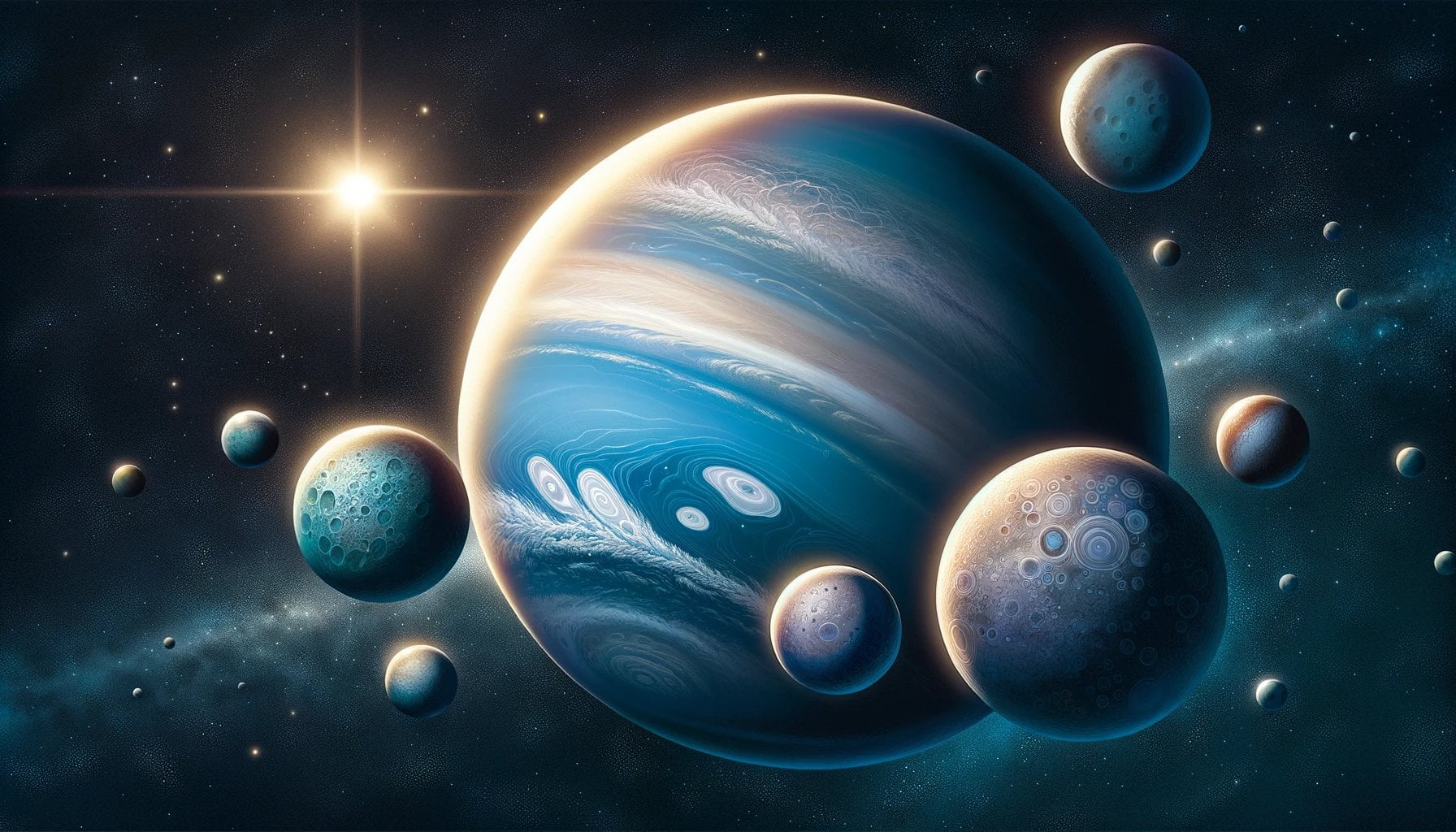Welcome to “Unveiling Neptune: 5 Fascinating Facts,” where we dive into the awe-inspiring world of Neptune, the eighth planet in our solar system. In this article, we will uncover intriguing details about Neptune’s atmosphere, its enigmatic planetary interior, and other remarkable facts that make it a captivating celestial body. So, if you’re ready to embark on a journey through the wonders of our vast universe, join us as we explore the mesmerizing secrets of Neptune- a planet that continues to intrigue scientists and astrophysics enthusiasts alike.

Key Takeaways:
- Neptune is the farthest planet from the Sun and the smallest of the ice giants.
- It has the second largest gravity and the strongest winds compared to any other planet in the solar system.
- Neptune’s atmosphere is dark, cold, and very active, primarily composed of hydrogen, helium, and methane.
- With 14 moons and a thin collection of rings, Neptune offers a unique view of its celestial surroundings.
- Discovered in 1846 by Jean Joseph Le Verrier, Neptune wasn’t known to ancient civilizations.
5 Facts About Neptune
Fact 1: Neptune, the Mysterious Ice Giant
Neptune, the most distant planet from the Sun, remains shrouded in mystery. As the smallest of the ice giants, it boasts an intriguing set of characteristics. With its second largest gravity and the strongest winds in the solar system, Neptune’s mesmerizing nature captivates astronomers and enthusiasts alike.
Fact 2: A Diverse and Active Atmosphere
Step into the realm of Neptune, and you’ll encounter a dark, cold, and remarkably active atmosphere. Composed primarily of hydrogen, helium, and methane, this thick, swirling concoction sets it apart from other planets. Its atmosphere is more than a mere blend of gases; it’s a canvas for awe-inspiring phenomena like swirling storms and colossal dark spots.
Fact 3: Moons and Rings: A Subtle Beauty
Neptune hosts a celestial entourage of 14 moons and a delicate array of rings. These moons, named after Roman and Greek water gods, add a touch of whimsy to the planet’s allure. Among them, Triton takes the spotlight as the largest and only spherical moon. Additionally, Neptune’s six faint rings elegantly adorn the ice giant, contributing to its celestial charm.
Fact 4: The Latecomer and its Orbital Journey
Unlike its ancient planetary counterparts known to the ancients, Neptune remained hidden from humanity’s gaze until 1846. Discovered by Jean Joseph Le Verrier, this latecomer orbits the Sun at a staggering distance, more than 30 times farther than Earth. Its orbital journey, encompassing 164.8 Earth years, landmarks Neptune as the most distant planet from our planet’s perspective.
Fact 5: Frigid Alien Lands and a Sea Ruler
Welcome to the coldest planet in our solar system, where temperatures plummet as low as a bone-chilling -366 degrees Fahrenheit. Neptune, aptly named after the Roman god of the sea, holds dominion over Pisces. Its icy terrain, revealing a rocky core cocooned by a thick layer of water, ammonia, and methane, hints at the enigmatic wonders that lie within.
As we delve deeper into the universe’s secrets, Neptune emerges as a captivating subject worthy of exploration. Its remarkable characteristics, from its awe-inspiring atmosphere to its far-flung moons, broaden our understanding of the cosmos and remind us of the boundless wonders that await beyond our planet’s borders. So let us embrace this icy giant, and let its mysteries fuel our curiosity and expand our cosmic perspective.
Table: Key Facts About Neptune
| Fact Number | Fact |
|---|---|
| Fact 1 | Neptune is the most distant planet from the Sun |
| Fact 2 | Neptune has the second largest gravity |
| Fact 3 | Neptune’s atmosphere is dark, cold, and active |
| Fact 4 | Neptune has 14 moons and a thin ring system |
| Fact 5 | Neptune was discovered by Jean Joseph Le Verrier in 1846 |
References:
- “Neptune” – solarsystem.nasa.gov
- “Neptune Facts” – theplanets.org
Neptune, the enigmatic planet with its mesmerizing blue shade, hides intriguing mysteries waiting to be unveiled. Want to dive into the captivating world of Neptune’s fun facts? Discover them by clicking here. Curiosity piqued? Find out why Neptune is so special by clicking here. Have you ever wondered how hot Neptune can get? Prepare to be amazed by clicking here. Oh, and did you know that Neptune is named after the Roman god of the sea? Explore Neptune’s connection to mythology by clicking here.
Neptune Facts On The Atmosphere
Neptune, the mysterious blue giant of our solar system, holds many captivating secrets within its atmosphere. Let’s dive into the mesmerizing facts about Neptune’s atmosphere and unravel its enigmatic nature.
1. The Color of Neptune’s Atmosphere
Neptune’s atmosphere appears a stunning shade of blue, but have you ever wondered why? It’s all thanks to the presence of methane, which absorbs red light, giving the planet its distinctive hue. Imagine a color palette where the reds are absorbed, leaving behind mesmerizing blues. Such is the captivating visual feast Neptune presents to the eyes of astronomers and stargazers alike.
2. A Dynamic and Active Climate
Neptune’s atmosphere is far from dull and stagnant. In fact, it boasts a highly active climate that is constantly in motion. The upper atmosphere of Neptune houses thin and high clouds, contributing to its ever-changing appearance. Winds whip across the planet at incredible speeds, reaching velocities of up to 1,200 miles per hour (2,000 kilometers per hour). This dynamic atmosphere showcases the true power and beauty of the celestial realm.
3. The Elemental Composition of Neptune’s Atmosphere
Hydrogen and helium dominate the atmosphere of Neptune, constituting approximately 80% and 19% respectively at higher altitudes. However, the presence of methane adds an intriguing twist to the mix, making up about 1% of the atmosphere. But that’s not all – traces of hydrocarbons, nitrogen, and various ices such as water, ammonia, and methane also find their place in Neptune’s atmospheric cocktail. These elements create an intricate blend, shaping the unique character of the planet and fueling scientific curiosity.
4. A Glimpse of Sunlight
Although Neptune lies far from the Sun, the light we perceive from its vibrant atmosphere is not intrinsic to the planet. Rather, it is reflected sunlight that illuminates Neptune, providing us with a mesmerizing view of its atmospheric dynamics. Picture a mirror reflecting the distant glow of our mighty Sun, allowing us to witness the captivating dance unfolding on this distant celestial body.
5. A Symphony of Exploration
As we continue to uncover the mysteries of our vast universe, Neptune’s atmosphere beckons us to delve deeper into its secrets. Exploring the composition, behavior, and unique features of this enigmatic atmosphere not only expands our understanding of the planet itself but also widens our knowledge of the universe at large. Neptune’s atmosphere serves as a symphony of exploration, inviting us to embark on a scientific journey that will forever shape our understanding of our cosmic home.
Key Takeaways:
- Neptune’s atmosphere appears blue due to the presence of methane, which absorbs red light.
- Its climate is dynamic and active, with high, thin clouds and winds reaching incredible speeds.
- The atmosphere is predominantly composed of hydrogen and helium, with traces of methane, hydrocarbons, nitrogen, and various ices.
- The light we see from Neptune is actually reflected sunlight, showcasing the planet’s atmospheric dynamics.
- Exploring Neptune’s atmosphere contributes to our understanding of the universe and opens new doors of scientific exploration.
Sources:
– Space-Facts: Neptune
– National Geographic: Neptune
Neptune Facts On The Planetary Interior
Neptune, the enigmatic blue giant of our solar system, holds not only captivating beauty but also intriguing facts that unlock its mysterious interior. Let’s delve into the depths of this majestic planet and uncover five fascinating facts about Neptune’s planetary interior.
1. The Core: A Solid and Icy Heart
Neptune conceals a solid and icy core beneath its turbulent atmosphere. Composed of rock and various ices, including water, ammonia, and methane, this core provides the foundation from which Neptune’s remarkable features emerge. With a mass roughly equal to Earth, this dense core is shrouded in mystery, fueling scientific curiosity about its exact composition and properties[^2^].
2. The Mantle: A Dynamic Mix
Surrounding the core lies Neptune’s mantle, a dynamic mix of water, ammonia, and methane. This region experiences extreme pressures and temperatures that transform these compounds into exotic forms, such as high-pressure ices and supercritical fluids. These unique conditions contribute to Neptune’s striking atmospheric phenomena and drive its energetic weather patterns[^2^].
3. The Hydrogen-Helium Envelope: A Gaseous Shroud
Above the mantle, Neptune is cloaked in a thick envelope of hydrogen and helium gases. Although this envelope comprises the majority of the planet’s mass, it is merely a small fraction of Neptune’s total volume. This gaseous shroud plays a crucial role in regulating the planet’s climate and influencing its atmospheric dynamics[^2^].
4. Extreme Pressure and Temperature
Deep within Neptune’s planetary interior, the combination of high pressures and temperatures gives rise to extraordinary states of matter. The pressures in Neptune’s interior can reach millions of times greater than Earth’s atmospheric pressure, while temperatures soar to thousands of degrees Celsius. These extreme conditions generate unique material behavior and may give rise to exotic forms of matter yet to be fully understood[^2^].
5. Magnetic Field: A Mystery Unraveled
Neptune’s planetary interior also encompasses its magnetic field, which is distinct among the planets in our solar system. This powerful magnetic field, generated by complex interactions between the core, mantle, and envelope, extends far beyond the planet itself and interacts with its surroundings. Scientists believe that Neptune’s magnetic field is tilted and off-center, adding to its enigmatic nature[^2^].
Key Takeaways:
- Neptune’s planetary interior consists of a solid and icy core, a dynamic mixture of water, ammonia, and methane in the mantle, and a hydrogen-helium envelope.
- Extreme pressures and temperatures in Neptune’s interior give rise to unique material behavior and exotic forms of matter.
- Neptune’s magnetic field, generated by complex interactions within its interior, is tilted and off-center, making it distinct among the planets in our solar system.
Learn more:
1. Space.com – Neptune: The Mysterious Blue Giant of the Solar System
2. NASA Solar System Exploration – Neptune

FAQ
Q1: What is the distance between Neptune and the Sun?
A1: Neptune is the most distant planet from the Sun and is located over 30 times farther away from the Sun than Earth.
Q2: How does Neptune compare in size to Earth?
A2: Despite being the smallest gas giant, Neptune has a diameter approximately four times that of Earth.
Q3: What kind of atmosphere does Neptune have?
A3: Neptune’s atmosphere is primarily composed of hydrogen and helium, with traces of methane. It also contains possible traces of hydrocarbons, nitrogen, and ices such as water, ammonia, and methane.
Q4: Why does Neptune appear blue?
A4: The presence of methane in Neptune’s atmosphere causes the planet to have a distinct blue hue.
Q5: What are some notable features of Neptune?
A5: Neptune has fierce winds and storms, with speeds reaching up to 2,100 kilometers per hour. It also possesses six faint rings and a collection of 14 known moons, including the largest moon, Triton.
- Senior at What Age: Benefits & Eligibility Guide - March 29, 2025
- Unlocking Senior Benefits: How Old is a Senior? Your Complete Guide - March 29, 2025
- Master Russian Politeness:A Guide to Saying Please - March 29, 2025
















